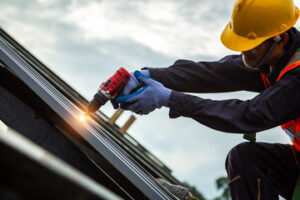A well-built roof shields a building’s occupants from rain, snow, wind, and sunlight. It also provides insulation and structural integrity. Roofing materials come in a wide variety of colors, finishes, and styles to suit style preferences.

A roof’s frame is constructed with rafters or prefabricated trusses. The sheathing, or deck, is plywood or oriented strand board. The slope of a roof is calculated by measuring its rise for every 12 inches of horizontal run. Get in touch with Arthur’s Roofing for professional support.
The roof is an important structural component that protects a building from the elements. A roof can be constructed from a variety of materials, and the cost of a new roof varies depending on the material chosen. Roof installation costs can also vary by location, as areas with harsh weather conditions require more durable roofing materials. The price of a new roof can also depend on whether it is being built into the construction of a home, or if it is being replaced because of damage or wear and tear. Reroofing typically involves working on the existing roof decking or sheathing, while replacing a roof can involve modifying the trusses and decking as well.
Materials
Your roofing material choice depends on a variety of factors. Some of the most important include your budget and the weather conditions in your area. For example, if your area is prone to high winds or heavy snows, you’ll want a roof that can withstand those conditions. Additionally, if your area is prone to wildfires or forest fires, you’ll want a roof made of a fire retardant material.
If you’re on a tight budget, asphalt shingles are an excellent option that offers durability and curb appeal. They’re also available in a variety of colors and styles to match any home.
Another popular choice is metal roofing. It’s available in a wide range of styles and materials, from galvanized steel to copper. It can also be curved to accommodate the curve of your roof. Metal roofs are typically designed for both low- and steep-sloped roofs, and they can be used on gable, hip, mansard, gambrel, bonnet, and flat roofs.
For a more traditional look, consider clay or concrete tiles. These are more expensive than other roofing options, but they offer a timeless style and are extremely durable. They also deflect extreme heat instead of absorbing it.
Other roofing options include terra-cotta and ceramic tiles, which can add a natural look to your roof and increase its value. They’re also one of the most energy-efficient roofing choices, as they reflect sun rays rather than absorbing them and transferring them to your house.
A newer roofing material is rubber slate, which is a mixture of recycled tire-derived rubber, cellulose, and binders. It’s resistant to fungus and insects, and it’s designed to last for up to 100 years. However, it’s heavier than other roofing materials and can be damaged by walking or satellite dishes.
Other types of roofing materials include rolled roofing, which is affordable and works well on both low- and steep-sloped structures. It’s easy to install, and it’s available in a variety of colors and textures. It’s also suitable for a variety of architectural styles, from bungalows to traditional designs. However, it shouldn’t be hammered onto a low-sloped roof, as this can lead to water leaks.
Installation
The roof is an important part of any home or building. It protects its inhabitants from the elements and keeps them comfortable during hot or cold weather. It also contributes to energy efficiency. There are many different types of roofing, each with its own strengths and weaknesses. A contractor can help you select the best type for your space and explain the process of re-roofing.
The first step in the roofing process is to prepare the area for installation. The contractor will remove any existing shingles and underlayment and clean the surface with a pressure washer. He will then apply a layer of water-resistant underlayment to the roof deck. The underlayment is then nailed to the roof deck with a nail gun, which speeds up the process and ensures a tight fit. The contractor will then nail the shingle to the underlayment with a pattern that includes close nails at the edge and those that are further apart towards the middle.
The next step is to add a layer of protective felt to the underlayment and waterproof it in the valleys. These areas are where the slopes meet in a “V” shape and usually get a lot of water running through them. The contractor will also install flashing around chimneys, wood stove pipes, certain vents and along the hip roof.
Maintenance
The roof is the outer covering of a building, protecting against rain, snow, sunlight, wind and extremes of temperature. It is an integral part of a structure, and is built in a variety of forms, including flat, pitched, vaulted, domed, or a combination of these, as dictated by technical, economic, or aesthetic considerations. Regular roof maintenance is important to preserving the structural integrity and comfort of your home or business.
Residential and commercial roofing can be made of many materials, each with their own specific maintenance requirements. A professional roofer can help you choose the best material for your property, and provide regular maintenance to keep it looking good. Many roofing products also come with manufacturer warranties that require regular maintenance to preserve their value and keep them eligible for future coverage, which can save you significant out-of-pocket expenses.
Depending on the nature of your roof, it may be necessary to use fall protection to perform certain maintenance tasks. In such cases, you should follow the principles of the hierarchy of controls to mitigate exposures and prevent injuries or fatalities.
